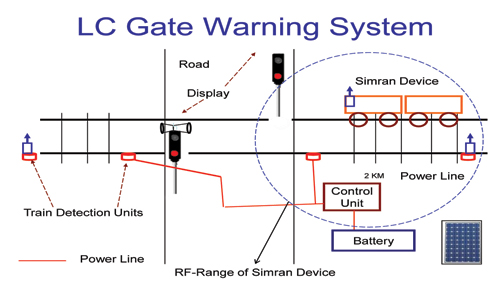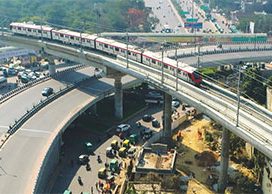Two researchers from Indian Institute of Technology, Kanpur have developed a new warning system for preventing accidents at unmanned level crossings in India.
The Indian Railways has long required a light and sound based  warning system for the more than 35,000 level crossing (LC) gates which includes nearly 23,000 unmanned LC gates. These are quite accident prone with many fatalities taking place each year. The reason for this seems that an unmanned LC gates does not have any kind of signalling or alarm system for people who cross them, though there are warning signs and boards. Some automatic equipment was placed over these unmanned LCs in the past but most of them got stolen. Thus there is a need for Automatic Warning System, a pilfer-proof one at that, which can sustain at such locations. The Unmanned Level Crossing Gate Warning System (ULCGWS) developed by researchers at IIT Kanpur is just that kind of system.
warning system for the more than 35,000 level crossing (LC) gates which includes nearly 23,000 unmanned LC gates. These are quite accident prone with many fatalities taking place each year. The reason for this seems that an unmanned LC gates does not have any kind of signalling or alarm system for people who cross them, though there are warning signs and boards. Some automatic equipment was placed over these unmanned LCs in the past but most of them got stolen. Thus there is a need for Automatic Warning System, a pilfer-proof one at that, which can sustain at such locations. The Unmanned Level Crossing Gate Warning System (ULCGWS) developed by researchers at IIT Kanpur is just that kind of system.
ULCGWS uses bi-directional wireless RF communication and SIMRAN Locomotive Equipment along with Identity Exchange Protocol, a data exchange protocol which was developed earlier at IIT Kanpur. Simran Equipment was developed during the project Simran under Technology Mission for Railway Safety. Simran stands for Satellite Imaging for Rail Navigation and is a pilot project which has been carried out for 18 pairs of important trains. It provides the precise location of trains through interactive mode on mobile phones and laptops, thereby eliminating the need for face to face telephonic enquiry. ULCGWS is a microprocessor based system having dual GSM, GPS and RF modules. The device broadcasts its location data for local devices within a 2000m range. When a train passes through any location, data gets exchanged between the train and the LC gate. To detect and convey the arrival of the train at the LC gate, and to provide a backup to this RF communication-link between the train and LC gate, the system uses load cells located approximately 2km from the LC gate in both the directions.
 The load cell detects a load of two tonnes or above as a train. Loads less than two tonnes per wheel are not detected, an example of which is the Push Trolley which weighs less than two tonnes. The communication between these detection locations and LC gate is done through RF channels. The load cell was included in the design to detect trains without Simran device approaching from both directions and to take care of reverse movements in them. Soon it was observed that the design with the load cell was not fit for this application due to heavy load as well as the vibrations due to the train, with the load cell unit getting disturbed. Because of this, the load cell device was placed over the unstable ballast.
The load cell detects a load of two tonnes or above as a train. Loads less than two tonnes per wheel are not detected, an example of which is the Push Trolley which weighs less than two tonnes. The communication between these detection locations and LC gate is done through RF channels. The load cell was included in the design to detect trains without Simran device approaching from both directions and to take care of reverse movements in them. Soon it was observed that the design with the load cell was not fit for this application due to heavy load as well as the vibrations due to the train, with the load cell unit getting disturbed. Because of this, the load cell device was placed over the unstable ballast.
When train nears the LC gate, information about its arrival is passed on to the LC system. The LC gate equipment actuates a red signal and an audible warning using 200db hooters placed both sides of the road. The system uses a three aspect colour light signal, with the red and yellow lights used for the warning signals and the hooters being used in place of the third colour light. The system stops the warning lights and audio warnings once the train passes the level crossing.
Working Description
The ULCGWS)comprises the following major sub systems:
• LC Gate Equipment along with Local Train Detection equipment.
• Remote Train Detection Equipment (2km from main unit on both sides)
• LC Gate Status Indicator Unit at station.
• Simran Onboard Equipment (fitted in the locomotive)
LC gate system is equipped with four sets of train detection units. Out of these, two sets are placed near LC to indicate whether a train has crossed the LC. The two sets which are placed at a distance of 2km from LC indicate that the train is approaching LC. The system is equipped with electric power as well as with solar power and a battery.
LC Gate Equipment receives data from Simran onboard equipment as well as from Train Detection Equipment, both of which broadcast messages in standard format at a frequency of 2.4GHz every three seconds. The equipment is designed not to accept messages in any other format or on any other frequency.
The local load cells are connected to the LC gate equipment directly through copper cables. When a message is received from Simran Onboard Equipment, a new entry is created in the LC Gate Equipment. This entry is maintained till the train clears the LC gate or 30 minutes, whichever is earlier. The LC Gate Equipment works out and maintains a status of Up Arrival, Up Clearance, Down Arrival and Down Clearance in its memory, based on reception of messages from the Train Detection Equipment.
Clearance of LC gate, when Onboard Equipment is working, is provided by comparing the coordinates to see if the locomotive has passed LC gate by 650 metres, which is the maximum train length permitted by the Indian Railways. When Onboard Equipment is not working, the detection is done by comparing load press on approaching Load Cells and Clearance Load Cells.
LC Gate Equipment processes the messages received from Simran Onboard equipment, Local Train Detection equipment and Remote Train Detection equipment. If LC Gate Equipment continuously gets messages from Simran Onboard Equipment, it ignores messages from Train Detection Equipment, and further processing is based upon data received from Onboard Equipment. If messages are not received from Onboard Equipment, further processing is based upon messages from Train Detection Equipment. When an oncoming train is detected based on signals received from either Onboard Equipment or from Remote Train Detection Equipment, the LC Gate Equipment initiates audio-visual warning at LC gate.
LC Gate Equipment continuously monitors the health of its own equipment and Remote Train Detection Equipment. This status is communicated to Station Control Panel each minute. The information communicated includes parameters such as solar charging voltage, solar charging current, battery voltage of LC Gate Equipment as well as of Remote Train Detection Unit along with Status of RF communication between LC Gate Equipment and Remote Train Detection Equipment. Further, failure of hooter, signal, failure of main processing unit & power supply are also communicated to the Station.
Panel layout of SM Monitoring Panel is given below. This Panel can monitor up to 4 LC gates.
A division control office based Remote Management System can monitor the health of all systems at regular intervals. Intervals can be set to any suitable value.
 TrafficInfraTech Magazine Linking People Places & Progress
TrafficInfraTech Magazine Linking People Places & Progress





